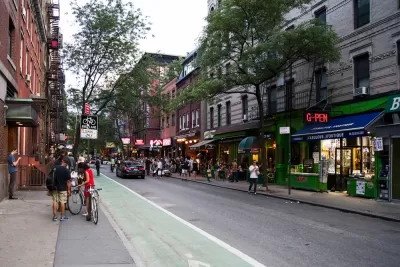Does the work of Jane Jacobs support restrictive zoning?

A recent article by law professor Richard Schragger invokes Jane Jacobs’ Death And Life of Great American Cities (“Death and Life”) in defense of zoning. Schragger writes that, according to Jacobs, city neighborhoods flourish because of “the diversity of land uses in space” and that zoning should protect the desirability of such neighborhoods by “zoning for diversity,” which requires “limiting development, controlling density, and preserving historic structures.” If a neighborhood becomes too popular, the ultimate result is the “self-destruction of diversity” or, in Schragger’s words, “when the features of a location that create housing demand are eliminated by fulfilling that demand-as when new high-rise construction replaces smaller, older, mixed-use buildings.”
The pages of Death And Life cited by Schragger (pages 242-52) mostly focused on commerce rather than housing. For example, Jacobs wrote that Eighth Street in Greenwich Village became overly dominated by restaurants and thus monotonous (p. 245). Third Street, by contrast, became too dominated by nightclubs and thus became disorderly (p. 245). Jacobs added that “banks, insurance companies and prestige offices” are especially destructive to diversity (p. 250).
However, Jacobs did have something to say about residential blocks. She wrote that when an area becomes popular, “it becomes profitable to build, in excessive and devastating quantity, for those who can pay the most. These are usually childless people… people who can or will pay the most for the smallest space.” As a result, families and uses less profitable than small apartment units are crowded out, causing the area to become duller.
As a remedy, Jacobs favored “zoning for diversity”—for example, historic preservation laws that ensure that in an area with a mix of low-and high-rise buildings, “the lower buildings remaining could not be further replaced by excessive duplication of the more valuable high buildings” (p. 253). It therefore appears that a Jacobs-inspired zoning code would consistently allow a mix of building heights, rather than zoning some blocks for tall buildings and others for smaller buildings.
However, current zoning does not resemble Jacobs’ ideas at all. Even in urban areas, zoning is designed to create sameness rather than diversity. Most residential land in many cities is zoned for single-family housing and nothing else. Even in New York City, there are many blocks where zoning forces all buildings into the same (usually low-rise) mold. When a building that differs from nearby buildings is proposed, neighborhood activists commonly claim that it is “out of scale” or changes the “neighborhood character.” Thus it seems to me that zoning, as currently configured, reduces rather than increases intra-block diversity.
Zoning in its current form hasn’t succeeded in protecting the kind of diversity that Jacobs wrote about. If any Manhattan neighborhood is frozen in its 1950s form, it is Jacobs’ beloved West Village. Of the 156 West Village apartments currently available for rent, all but 40 are pre-war (that is, built before World War II). If the refusal to accommodate new construction created economic diversity, the West Village would be cheaper and more diverse than newer areas. Instead, the West Village is now one of the city’s most expensive areas; 135 of the apartments (or about 87 percent) rent for $4000 or more, which certainly freezes out economic diversity.
Jacobs suggested that the right kind of zoning would make neighborhoods more family-oriented. Is the West Village more family-friendly than other parts of New York City? According to city-data.com, 16 percent of West Village residents over age 3 are in K-12 schools, about the citywide average.
By contrast, the Upper East Side, another elite part of Manhattan, is newer: only 364 of its 747 for-rent units are pre-war. Has the relative newness of the area driven out diversity? When compared to the West Village, Upper East Side rents are somewhat lower; only about 60 percent (451 out of 747) rent for $4000 or more. And the UES is actually more family-friendly than the West Village; 21 percent of its non-infant residents are in K-12 schools. In the nearby Upper West Side, the percentage is 26 percent.
In sum, Jacobs’s “zoning for diversity” doesn’t resemble zoning as it actually functions today. Thus, it seems unreasonable to invoke her work to support anything resembling the zoning status quo. Moreover, urban zoning as it currently functions doesn’t support Jacobs’ policy goals: affluent neighborhoods that have most successfully excluded new housing aren’t always particularly diverse or family-oriented.

Alabama: Trump Terminates Settlements for Black Communities Harmed By Raw Sewage
Trump deemed the landmark civil rights agreement “illegal DEI and environmental justice policy.”

Study: Maui’s Plan to Convert Vacation Rentals to Long-Term Housing Could Cause Nearly $1 Billion Economic Loss
The plan would reduce visitor accommodation by 25% resulting in 1,900 jobs lost.

Planetizen Federal Action Tracker
A weekly monitor of how Trump’s orders and actions are impacting planners and planning in America.

Waymo Gets Permission to Map SF’s Market Street
If allowed to operate on the traffic-restricted street, Waymo’s autonomous taxis would have a leg up over ride-hailing competitors — and counter the city’s efforts to grow bike and pedestrian on the thoroughfare.

Parklet Symposium Highlights the Success of Shared Spaces
Parklets got a boost during the Covid-19 pandemic, when the concept was translated to outdoor dining programs that offered restaurants a lifeline during the shutdown.

Federal Homelessness Agency Places Entire Staff on Leave
The U.S. Interagency Council on Homelessness is the only federal agency dedicated to preventing and ending homelessness.
Urban Design for Planners 1: Software Tools
This six-course series explores essential urban design concepts using open source software and equips planners with the tools they need to participate fully in the urban design process.
Planning for Universal Design
Learn the tools for implementing Universal Design in planning regulations.
Caltrans
Smith Gee Studio
Institute for Housing and Urban Development Studies (IHS)
City of Grandview
Harvard GSD Executive Education
Toledo-Lucas County Plan Commissions
Salt Lake City
NYU Wagner Graduate School of Public Service



























